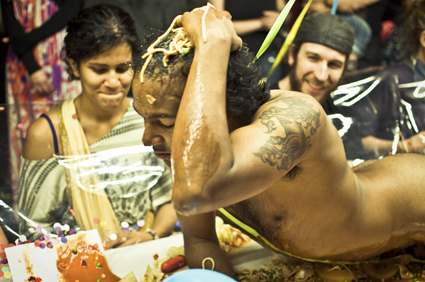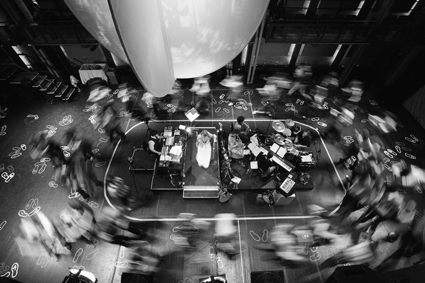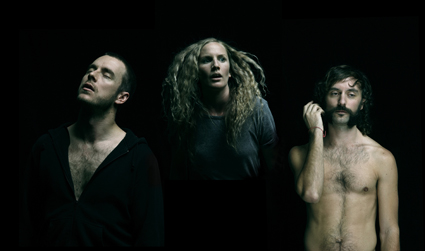 |
Ahil Ratnamohan, Sweat, Branch Nebula photo Heidrun Löhr |
To discuss “the Massive” I met with Steven Richardson, Director of Arts House in Melbourne. Richardson was instrumental in founding Dance Massive, urging the Australia Council following his time on the Dance Board to consider a concentration of dance programming both to attract international attention to new work and to provide a place for the sector to meet and share experiences at a national level. Arts House, a complex of venues run by City of Melbourne, plays a central coordinating role for the Dance Massive program, although Richardson admits that, “surrendering half of our six month program to make this work is not ideal.”
Without an artistic director for Dance Massive, Richardson tells me, there is no festival infrastructure and all programming is supported by existing State and Federal resources allocated to the three Melbourne venues where the work is presented. “There hasn’t been the funding to create a central framework. When the idea first came up, we considered trying to create a national program by coordinating venues around the country. It quickly became apparent that this was going to be impossible. It would take 15 years for us to find the same two weeks across every dance venue nationally. So we decided to start in our own backyard.”
The coincidence of Malthouse Director Michael Kantor and producer Stephen Armstrong investing in contemporary dance and physical theatre programming and the energy of David Tyndall as the new(ish) Director of Dancehouse created sufficient momentum in Melbourne for the project to take off in 2009. “It’s hard to apologise for the focus on Melbourne,” Richardson says, “There is arguably the healthiest ecology for dance here, with a concentration of institutions, companies like Chunky Move and lots of independent artists and audiences.”
In its first edition Dance Massive programmed 14 works from across Australia across the three venues. The program was well attended and received positive feedback and critical acclaim. Dance Massive was also pronounced a success for the way in which it raised the profile of dance in the media and created a meeting point for artists and companies to see each others’ work and network during a concentrated period. The same venues have joined to create Dance Massive 2011, and several of those artists included in the original program are making a return appearance. “We each have our own curatorial framework, our own audiences and remits regarding programming,” says Richardson. “but there has been some very interesting cross-fertilisation between the venues since the first Massive,” he adds. “There has been surprisingly little tripping over each other too; we are all interested in contemporary work, but our curatorial approaches are slightly different and we have worked hard to ensure that the work falls where it needs to fall.”
Richardson is referring to the fact that the program is broad, both in terms of its definition of dance (including a physical theatre company such as Branch Nebula), its inclusion of generations of makers, (from Trevor Patrick to Luke George) and its accessibility (from the popular dance theatre work of Force Majeure and Shaun Parker to the relatively obscure independent work of Deanne Butterworth and Matthew Day).
 |
Dance Marathon, bluemouth inc photo Gordon Hawkins |
 |
Now, Now, Now, Luke George photo Jeff Busby |
Richardson goes on to talk about the National Dance Forum associated with Dance Massive as a place where conversations around Indigenous and regional work can take place. “We have been able to include more spaces-in-between this year,” he says and cites the two international residencies and the dance on film program as initiatives that seek to address the aspiration of all three venues to create a place where dance artists and enthusiasts can meet. The National Dance Forum, led by Ausdance and the Australia Council and taking place over a long weekend during Dance Massive, will involve international choreographers such as Pichet Klunchen from Thailand with national dance artists in a series of forums, conversations and provocations designed to inspire art form development, in a similar fashion to that achieved during the National Theatre Forum in 2010.
Arts House will host the 2011 Tanja Liedtke Foundation Fellow, Katarzyna Sitarz, during Dance Massive. Sitarz will direct a residency at Arts House that will involve local independent artists and will take part in a new collaborative project directed by Lucy Guerin. Also during Dance Massive, the Australia Council’s IETM program, directed by David Pledger in Brussels, will send Norwegian choreographer Heine Avdal of deepblue company to undertake a residency and build relationships with Australian dance artists.
The venues and companies worked together to create a hit list of international presenters to invite to Dance Massive. Around a dozen high profile programmers from Europe, Asia and the US will attend. Dancehouse will also target a handful of French presenters in a special initiative. “It is important for the work to be shown in full, in the best possible theatrical conditions,’ Richardson says. “We also try to attract national and regional presenters,” he continues, “Although that is never easy. Last time we had half a dozen regional presenters attend and this year we hope for more.”
Richardson is optimistic about the impact of the 2011 program and is particularly looking forward to the two new productions by Chunky Move as well as the site-specific presentation, Drift, by Anthony Hamilton and the sound installation by composers Madeleine Flynn and Tim Humphrey. “I am hoping some of these projects will turn a few heads about what the nature of dance engagement can be,” he says.
Despite his enthusiasm, Steven Richardson is sanguine about the future of Dance Massive with no illusions about the third edition planned for 2013 being a shoo-in. “Once we get through March, we will start thinking about what we want Dance Massive to be,” he says. “Perhaps there is another model out there; something more nimble or more relevant to current practice.” Dance Massive is not a festival, or a showcase, that much is clear, but what it is and what it could be, seems to be tantalisingly up for grabs.
Throughout Dance Massive, RealTime reviews and interviews will appear online at www.realtimearts.net.
The considerable Dance Massive program includes works by Chunky Move, The Shaun Parker Project, Narelle Benjamin, Michelle Heaven, Helen Herbertson, Balletlab, Deanne Butterworth, Matthew Day, Antony Hamilton, Force Majeure, Trevor Patrick, Luke George, Branch Nebula, overseas guests Billy Cowie, John Jasperse Company and bluemouth inc, and the welcome return to Australia from France of Rosalind Crisp and Andrew Morrish.
Dance Massive: partners Arts House, Malthouse Theatre, Dancehouse; Melbourne, March 15-27; download the program at www.dancemassive.com.au
© Sophie Travers; for permission to reproduce apply to [email protected]








 back
back